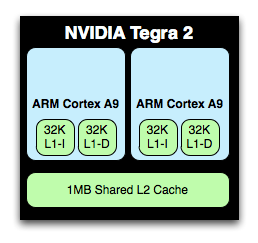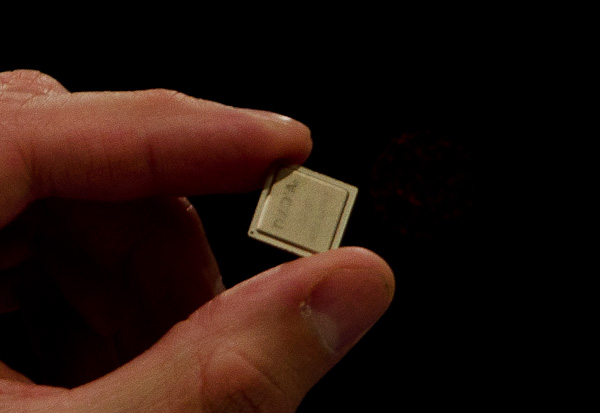NVIDIA's Project Kal-El: Quad-Core A9s Coming to Smartphones/Tablets This Year
by Anand Lal Shimpi on February 15, 2011 9:05 PM ESTThe Architecture
Kal-El looks a lot like NVIDIA's Tegra 2, just with more cores and some pin pointed redesigns. The architecture will first ship in a quad-core, 40nm version. These aren't NVIDIA designed CPU cores, but rather four ARM Cortex A9s running at some presently unannounced clock speed. I asked NVIDIA if both the tablet and smartphone versions of Kal-El will feature four cores. The plan is for that to be the case, at least initially. NVIDIA expects high end smartphones manufacturers to want to integrate four cores this year and going in to 2012.

The CPU cores themselves have changed a little bit. Today NVIDIA's Tegra 2 features two Cortex A9s behind a shared 1MB L2 cache. Kal-El will use four Cortex A9s behind the same shared 1MB L2 cache.
NVIDIA also chose not to implement ARM's Media Processing Engine (MPE) with NEON support in Tegra 2. It has since added in MPE to each of the cores in Kal-El. You may remember that MPE/NEON support is one of the primary differences between TI's OMAP 4 and NVIDIA's Tegra 2. As of Kal-El, it's no longer a difference.

Surprisingly enough, the memory controller is still a single 32-bit wide LPDDR2 controller. NVIDIA believes that even a pair of Cortex A9s can not fully saturate a single 32-bit LPDDR2 channel and anything wider is a waste of power at this point. NVIDIA also said that effective/usable memory bandwidth will nearly double with Kal-El vs. Tegra 2. Some of this doubling in bandwidth will come from faster LPDDR2 (perhaps up to 1066?) while the rest will come as a result of some changes NVIDIA made to the memory controller itself.
Power consumption is an important aspect of Kal-El and Kal-El is expected to require, given the same workload, no more power than Tegra 2. Whether it's two fully loaded cores or one fully loaded and one partially loaded core, NVIDIA believes there isn't a single example of a situation where equal work is being done and Kal-El isn't lower power than Tegra 2. Obviously if you tax all four cores you'll likely have worse battery life than with a dual-core Tegra 2 platform, but given equal work you should see battery life that's equal if not better than a Tegra 2 device of similar specs. Given that we're still talking about a 40nm chip, this is a pretty big claim. NVIDIA told me that some of the power savings in Kal-El are simply due to learnings it had in the design of Tegra 2, while some of it is due to some pretty significant architectural discoveries. I couldn't get any more information than that.

Kal-El vs. Tegra 2 running 3D game content today at 2 - 2.5x the frame rate
On the GPU side, Kal-El implements a larger/faster version of the ULP GeForce GPU used in Tegra 2. It's still not a unified shader architecture, but NVIDIA has upped the core count from 8 to 12. Note that in Tegra 2 the 8 cores refer to 4 vertex shaders and 4 pixel shaders. It's not clear how the 12 will be divided in Kal-El but it may not be an equal scaling to 6+6.
The GPU clock will also be increased, although it's unclear to what level.
The combination of the larger GPU and the four, larger A9 cores (MPE is not an insignificant impact on die area) results in an obviously larger SoC. NVIDIA measures the package of the AP30 (the smartphone version of Kal-El) at 14mm x 14mm. The die size is somewhere around 80mm^2, up from ~49mm^2 with Tegra 2.











76 Comments
View All Comments
heinzr - Thursday, February 17, 2011 - link
How can Nvidia claim that Kal-El offers 5x Tegra performance without getting challenged? The Coremark result is better by less than 2x.tecknurd - Thursday, February 17, 2011 - link
Where is the power consumption numbers? All reviewers that I read still did not post those numbers and I was hoping to see power consumption numbers here, but did not find any. Saying that the Kal-El will have a same power consumption as Tegra 2 does not mean anything to me because I do not know how much power a Tegra 2 realistically consumes. I know how much the BeagleBoard consumes which is around 3 to 5 watts. I expect the PandaBoard to consume about double. If they are going to state the power consumption, I will just predict the power consumption of the Kal-El be around 15 watts. Is this wrong or am I right?Wilco1 - Friday, February 18, 2011 - link
At 40nm, a dual core 2GHz Cortex-A9 uses 2W. So 4 1.5GHz Cortex-A9 cores will use ~2.5-3W. So with the GPU, a total of ~4-5W seems reasonable.While that seems a lot, consider that the lowest power Atom needs 2W per core at 1.5GHz, and that you'll need 4 of those plus a fast GPU to get similar performance.
ioannis - Friday, February 18, 2011 - link
surely Parker should have a place in that chart, don't you think? Or is he more of an AMD/ATI colour-themed hero?IamEzio - Friday, February 18, 2011 - link
the NGP has quad core Cortex A9 ..dagamer34 - Saturday, February 19, 2011 - link
Engadget's video around 3:45 has the rep clearly stating that Kal-El will support high-profile H.264. It'll also handle a Blu-ray rip (and I don't really know of any commonly used video that higher quality than that right now).Link: http://www.engadget.com/2011/02/15/nvidia-announce...